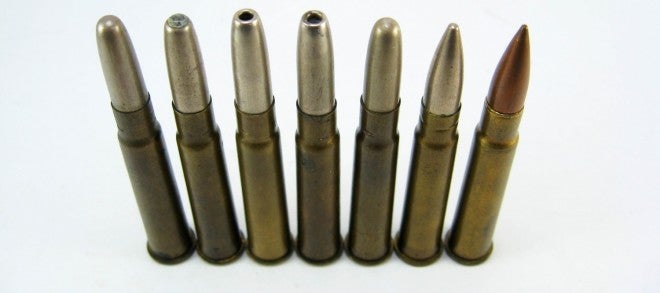It’s not commonly remembered in today’s world of .22 caliber infantry rifles that once upon a time .30″ was “small caliber”, and with that came all of the doubts an questions about wounding and killing power of such small bullets. LooseRounds has posted an 1891* article by the New York Times, entitled “What Are They Good For? Speculation As To The Value of Small-Calibre Pieces”, expressing such concern about the effectiveness of the new miniature ammunition:
In further comment, Captain Surgeon Marsh points out that, inasmuch as the resisting surface offered to the fact of a small-calibre bullet has been thus reduced, the ball penetrates and passes through the tissues without having expended much of its energy in their destruction. Its track is so narrow that there is practically no destruction of substance in its path. Such a ball might pass through a large joint without touching the bones, or between the two bones of the forearm or leg without injuring them in the slightest, thus producing nothing more than a simple flesh wound, not grave enough to place the wounded man hors de combat.
A larger calibre ball, say of the Martini type, .45 calibre, striking in similar situations would inevitably shock the system and shatter the bones to such an extent as totally to disable the soldier for many months, if not for life. In adopting a lighter and smaller calibre ball there is sacrified to a great extent the stopping power and shock possessed by the larger missiles. Impart shot produced by the magazine bullet is also further mitigated by the fineness or sharpness of the missle’s point. Then, too passage through the tissues of the body is further facilitated by the rapid rotary movement around its long exist which is the property of all moving rifle bullets. This rotation aids in screwing the point onward and facilitates the penetration of a moderately resisting substance.
In consequence of the great penetrating power of the small-calibre ball, the belief is ventured that in many instances this power is likely to prove a useless surplus, purchased at the expense of a decrease destructive power. As to the ability claimed for the small caliber bullet of being able to pass in succession through the bodies of men three and even four feet deep, little value, it is thought, comes from this fact, owing to the open formations employed in the field tactics of the present day. As a result of the use of the high-powered small-calibre rifle, military surgeons will doubtless find, in working over wounded men, (1) diminished shock; (2) wounds clean-cut, much decreased in size, and with little destruction of parts; (3) wounds uncomplicated by the lodgement of the ball, or by splinters of lead, or any other foreign body; (4) union of wounds by “first intention,” and rapid recovery.
…
According to the Captain Surgeon Marsh, there is every reason to believe that in consequence of the small-calibre ball future engagements will be marked by resulting large numbers of wounded, of which the majority will be only slightly wounded, and capable of returning to the ranks if skillfully treated in the course of a few weeks. Whether this fact is advantageous or not is a queston for military ment to consider.
There is at least the benefit of hampering and enemy with crowded hospital trains, but if this same enemy can from time to time be reinforced by large numbers of recovered men, soldiers of experience, the effect will be one not heretofore counted upon.
Here we can see similar concerns to those that faced (and still do) the .22 caliber ammunition used in the past half-century: Reduced diameter will lead to a lack of “shock” or stopping power, smaller caliber bullets will leave their targets laid up for only a short while with only minor flesh wounds, and finally, that if small caliber rounds do prove to be any use at all, it will only be to clog the enemy’s lines with wounded. The article is even rounded out by a paragraph praising the legendary maiming power of larger-caliber rounds.
Early small-caliber rounds such as the .303 British did experience some effectiveness issues in their initial round-nosed form. This form of bullet not only lost energy rapidly compared to later streamlined projectiles, but also remained stable in tissue to a great depth, and were clad with tough metal jackets designed to hold the bullets together at the high velocity at which they were fired. Many solutions were found to this problem including the early jacketed hollow point, an invention generally attributed to the British. Eventually, the aerodynamic spitzer projectile replaced the older round-nosed one, and brought with it a much flatter trajectory, higher velocities, better energy retention, and perhaps most importantly a much shorter depth at which the round loses stability in tissue and deposits its energy, effectively solving in a manner compliant with the Hague convention the effectiveness limitations of small-caliber projectiles.
 Your Privacy Choices
Your Privacy Choices
